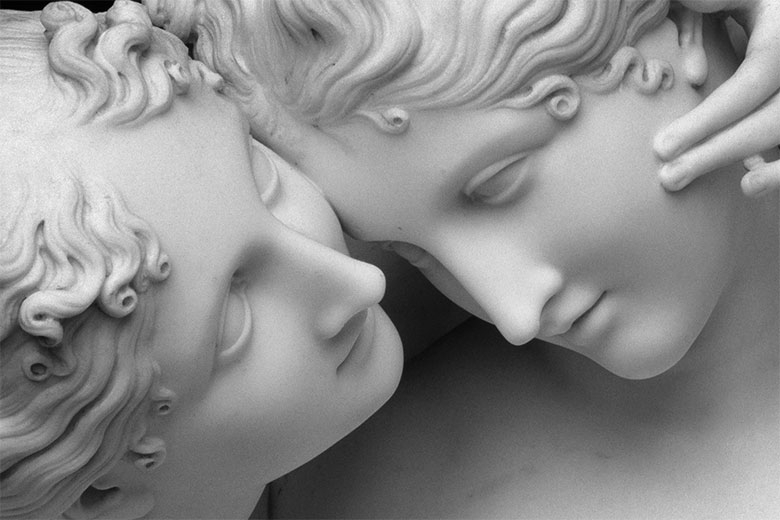

Antonio Canova and Bertel Thorvaldsen, the two sculptors currently on show in Milan, share the the desire – together with the ability – to capture ideals in marble, to make beauty permanent. When I left the gallery I found myself spontaneously comparing this search for infinity with various forms of contemporary art – its transience, preoccupation with the finite, and the typically perishable materials today’s artists choose to work with. Bio art, edible art, land art are artistic proposals that are deliberately designed to disappear, communicating the awareness of human transience; every form of eternity has disappeared, testifying to our dark times. This exhibition therefore offers an escape from the contemporary – albeit a temporary one.
The unforgettable setting of the Gallerie d’Italia in Milan is also home to a bank designed by the early 20th-century architect Luca Beltrami. Its stained glass, marble and Art Nouveau decorations are outstanding, creating a worthy atmosphere for an equally outstanding exhibition: two neoclassical sculptors, Canova and Thorvaldsen, are compared through 160 works on loan from the Hermitage in St Petersburg, the Thorvaldsen Museum in Copenhagen, and the Gypsotheca in Possagno in the province of Treviso.
Antonio Canova (1757-1822) was born in Possagno and moved to Rome in 1781. He was a small, thin man with thinning hair, but with incredible energy and talent: reports from the time always describe him covered in white marble dust and carrying his hammer and chisel in the large laboratory where he worked. Here his masterpieces were born, figures of perfection frozen forever in marble. The marble came from Carrara quarries and was was expensive and difficult to transport. Therefore, before sculpting it, Canova prepared a sketch on paper, followed by a clay draft, which was shown to the customer for approval. A true businessman, he also had a catalogue of works the buyer could choose from. From there he made a plaster model, which was covered with metal pins, the so-called reperes, or markers, which served as indicators for making the marble copy. At this point his assistants rough-hewed the marble. The last phase, however, was always done by the artist, who filed and smoothed the marble, sometimes even passing a kind of wax over it to make it as polished as possible, as resplendent as human skin.
The idea of reproducibility arises from the possibility of making multiple sculptures from the same sketch: the seriality that characterizes pop art has distant roots.
Bertel Thorvaldsen (1770-1844), arrived in Rome from his native Copenhagen in 1797 and employed several artists as assistants in his laboratory. For 20 years these two sculptors set the standard in the artistic field and challenged each other on similar themes, even if the realisation of their works was different. Both neoclassical artists, their favourite themes were from Greek mythology. While imitating the ancient Greeks, however, they reinterpreted the universal themes of mythology in a modern way. The cult of beauty, in a period devastated by wars, is considered a fundamental remedy for humanity, as a balm to heal wounds: religious ideals were replaced by the ideals of classicism and civil values.
The layout of the central exhibition hall is stunning: in the vast Art Nouveau setting the white marble of the statues contrasts with the black pedestals on which they are placed. If we look closely at Canova’s Three Graces (which represent the three virtues of women of the time, beauty, intelligence, or, according to another interpretation, the secular version of the Trinity), we see three girls perfect in form and sensuality, with elaborate hairstyles and serene faces. The girls dance to silent music, the same that, according to Plato, resounds in the Universe. It seems that human warmth is locked forever in the marble.
Thorvaldsen, who addressed the same subject, added the statue of Cupid, god of love, seated on the ground by the girls. The figures, although beautiful, are still and without any hint of dance; they are more chaste and less expressive, even if their bodies are just as perfect. The sensuality of Mediterranean art can also be compared with the greater coolness of Nordic art when looking at the two sculptors’ interpretations of Venus. The goddess of love who comes out of the waters covering herself with a cloth is the picture of natural femininity for Canova, while Thorvaldsen portrays her in a more conventional manner and over posed.

We stop enchanted in front of the two depictions of Cupid and Psyche, which in Apuleius’ fable represent love and the soul. Canova’s Psyche is holding a butterfly (the soul), which the two lovers observe intently; in Thorvaldsen’s version, Psyche holds an amphora and appears more concrete, less dreamy.
As well as mythological subjects, the two artists created sculptures of powerful men. Canova was commissioned by Napoleon Bonaparte to create a bust of the emperor, followed by a colossal statue that was to be housed in the Louvre. While the bust was enormously successful, so much so that 22 copies were made, the statue of Napoleon as a victorious Mars did not please the customer. After the defeat of Waterloo, it was donated to the winner of the battle, the Duke of Wellington, who knocked down a wall of his house to get it in: Wellington is said to have always wanted to have Napoleon prisoner in his house. Thorvaldsen in turn portrayed Napoleon with the insignia of command and power.
As evidence of the success that the two artists had in life, a series of portraits depicting them and sculptures made by their followers are also on display.
Liviana Martin
Volume 34 no 4 March/April 2020 pp 20-21
Canova/Thorvaldsen – The Birth of Modern Sculpture
Gallerie d’Italia, Milan, until March 15, 2020, admission 10 euros

